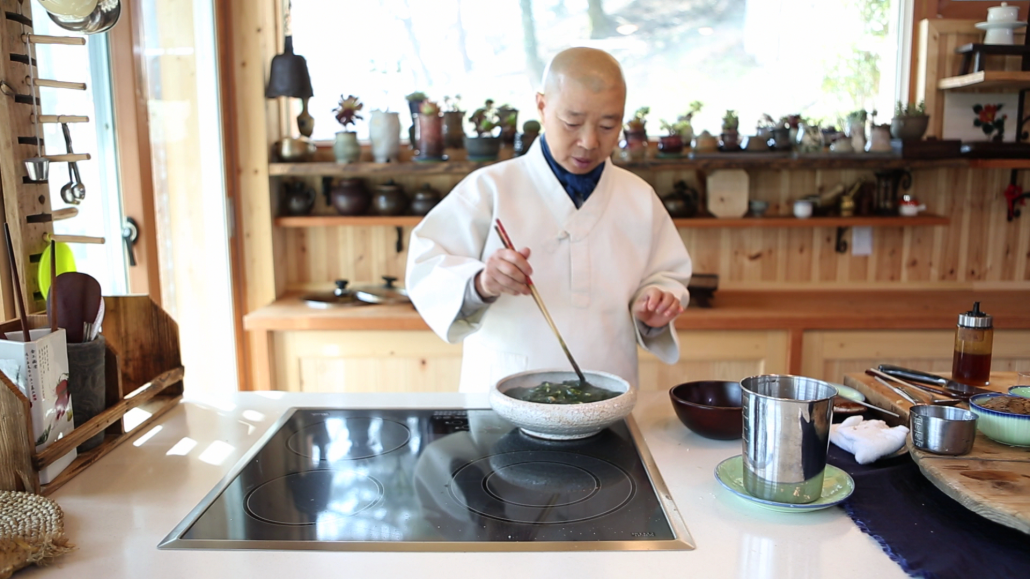For centuries, seaweed has been an integral part of the Korean diet. There's Miyeok (sea mustard/wakame), the most common seaweek usually dried and cooked in soups. Dried dasima (kelp) is the go-to ingredient for making soup and stew bases, often combined with dried anchovies and turnips for a light savoury broth. And if you grew up in Korea, you'll likely have fond memories of enjoying dried gim (nori) lightly toasted, brushed with sesame oil and wrapped around freshly-steamed rice.
Then there's maesaengi. This variety has become increasingly popular in recent years outside of the pristine southern coastal regions (including Gangjin and Wando in Jeollanamdo Province) where it is farmed from December to March. At first glance, fresh maesaengi has a wispy form and vivid green colour. But run your fingers over the impossibly silky soft strands of seaweed, so delicate they could break at the slightest touch.
Come December, farmers place bamboo mats in the shallow waters close to the shore where the maesaengi gametes and spores drift in from the ocean and attach themselves to the bamboo. This delicate seaweed is notorious for growing only in the cleanest unpolluted waters where the temperatures range between 5–10°C.
January is when harvest begins, when the seaweed sprouts to a length of 15 to 20cm. It's the coldest month of the year, and the maesaengi harvest is an arduous task; the slippery seaweed requires farmers to gather every strand by hand. The seaweed is removed from the bamboo mats, washed and formed into dark green bundles, then packed into containers.

How do Koreans consume maesaengi? Maesaengi is most commonly added to clear soups together with oysters which are in season around the same time. The subtle ocean flavour of both complement each other well. Maesaengi jeon (savoury pancakes) and maesaengi juk (rice porridge) are also common dishes eaten in Korean households.
For cooks handling the delicate seaweed for the first time, maesaengi is sensitive to heat. Made up of 60% air, the seaweed will melt away if over-boiled. Maesaengi is also sensitive to acidity, and will dissolve if soaked in vinegar.
It's also a skill eating maesaengi soup. As a Korean saying goes: “You serve maesaengi soup when you hate your son-in-law.” The seaweed is notorious for hiding all the hot steam under its blanket of fine tangled threads even when it reaches boiling temperatures.
If you have leftover maesaengi, remove all the air, wrap it tightly and freeze it. It will last for up to a year.

Buddhist monk Jeong Kwan at Baekyangsa Temple, celebrated for her timeless and elegant temple cuisine, shares her recipe for braised maesaengi.
“Every time I feed people, I am offering them the universe on a plate," says Jeong Kwan.
As with all Korean temple food, the following recipe is vegan-friendly.
Recipe for Maesaengi Jjim
Ingredients
- 1 bundle of maesaengi (around 400g)
- 2 fresh shiitake mushrooms
- 1/2 fresh green pepper
- 1/2 fresh red pepper
- 1 cup of lotus leaf-infused water
- 1.5 tablespoons of sesame oil
- 1.5 teaspoon of soup soy sauce
- 1 teaspoon of crushed sesame seeds
- Sea salt to taste

Method
- Wash maesaengi and drain.
- Slice shiitake mushrooms and lightly season them with 1/2 teaspoon of soup soy sauce and 1/2 teaspoon of sesame oil.
- Saute in a pan. Leave to rest until ready to use.
- Thinly slice green and red peppers.
- Add cooked shiitake mushrooms to 1 cup of lotus leaf-infused water and boil.
- Season with soup soy sauce.
- Add maesaengi to the boiling broth and stir continuously in one direction.
- When the maesaengi turns bright green, drizzle with the remaining sesame oil. Stir a few times more and turn off heat.
- Plate the maesaengi and top with the sliced green and red peppers as well as the crushed sesame seeds.
- Serve as a side dish with rice.





















